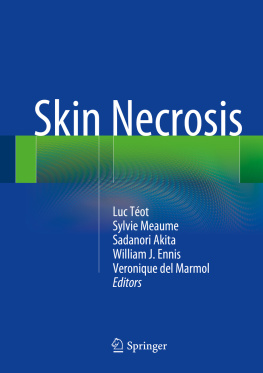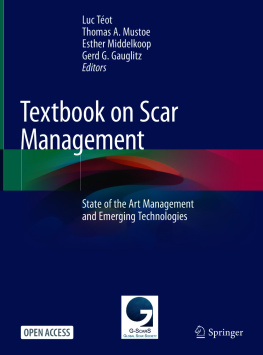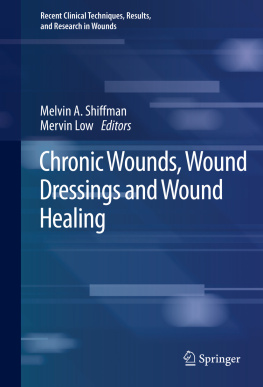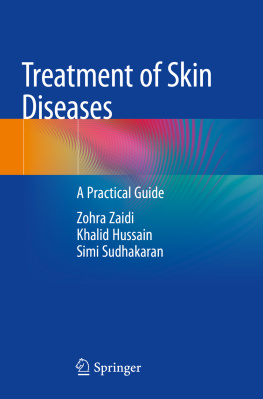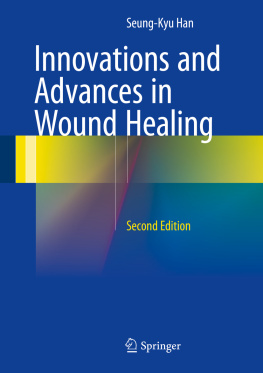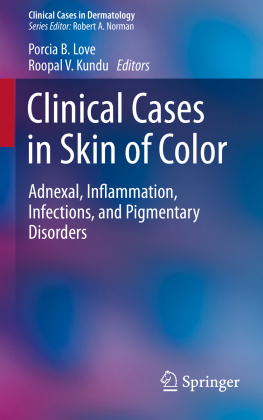1.1 Introduction
Skin necrosis is a result of several factors.
Ischaemia of a skin territory leads to venous congestion, which blocks microcirculation. The damage caused may remain reversible for a few hours, but 6 h or more of ischaemia lead to an irreversible situation and tissue loss. Several factors contribute to ischaemia. The most common is thrombosis of small arterioles, which progress, together with regional inflammatory processes, to devascularisation of a defined anatomical territory (angiosome). During the spreading of infections, necrosis is linked to the destructive effect of germs, which induce tissue damage by simple germ proliferation or induce vessel thrombosis. The germs may also secrete toxins, which are diffused inside the arteriolar and capillary vascular systems. This leads to rapid obstruction of the vessels by chemical intimal and subintimal lesions, causing necrosis of large territories involving not only the skin but also the underlying muscles, tendons and bones.
1.2 The Skin Necrotic Process
Subdermal necrosis may be induced by excessive pressure, leading to a mechanical crush. This is the most common factor in pressure ulcers and diabetic foot ulcers. In this situation, successive stages of skin necrosis can be observeda situation reflected in the non-blanching stage 1 pressure ulcer following the National Pressure Ulcer Advisory Panel (NPUAP) classification, which probably corresponds to a prenecrotic stage. This is also observed in extravasation injuries [].
Epidermal-dermal necrosis may rapidly appear at the skin surface. However, in some areas, such as the foot or when the depth of keratinized epidermis is thick, the necrotic tissue may resemble a subepidermal collection. This is partly because of the Tyndall effecta light scattering observed when particles are present in colloid suspension, with blue light being much more strongly affected than red light.
When mature, this subdermal necrosis is easily confused with a deep hematoma. This situation is often observed on the heel.
The time to complete the necrosis may vary from 6 h to 23 days, depending on the state of vascularisation of the limb. It may be more progressive, such as observed during terminal limb ischaemia or during angiodermatitis. Microvascular impairment, autoimmune vasculitis, macroangiopathy and venous blockade are the most frequent causes, together with infection and microarterial emboli.
Dermal necrosis may be accompanied by fasciitis, especially during a severe infection such as necrotising fasciitis, where the presence of germs secreting highly active toxins quickly involves all surrounding tissues and creates a regional progressive necrosis, a spreading infection rapidly leading to a septicaemic life-threatening shock. The proliferation of germs is facilitated at the level of fatty tissue, such as in Fournier gangrene involving the perineal area and progressing very quickly under the skin.
Others toxins and venoms may be secreted by a series of different animals (snails, mosquitoes) and may create an intense local inflammatory process leading to localised skin necrosis combined with an extensive subepidermal tissue degradation [].
1.3 Wet Necrosis
Necrotic tissue and the normal skin with which it is in contact are both adherent to each other for a period of time of around 1 week. Separation starts with a fissure occurring between normal and necrotic tissues, initiated by a difference in mechanical resistance and elasticity. This dissociation creates the elimination fold, allowing the germs to penetrate deeply and to destroy the mechanical links between dead and living tissues. These germs proliferate in the subdermal fatty tissues. In large burns the dissemination of germs all over the involved area are the main cause of death.
In some situations the necrotic tissue presents as wet, usually when necrosis is covered with damp dressings, allowing anaerobes to develop. This wet necrosis is often seen on the heel or other parts of the foot, the perineum, places and where maceration usually occur. Wet skin necrosis is considered to be at high risk of local infection, and should be quickly removed.

